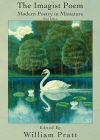The Imagist Poem
It was during the decade of the First World War, 1910-1920, that the Imagist poem came to fruition. Imagist poetry was part of the literary revolt in the United States and England against the staid and formal techniques of the nineteenth century. William Pratt, in the introduction to his indispensable anthology The Imagist Poem – Modern Poetry in Miniature, quotes Imagist poet F.S. Flint’s three rules by which the Imagist poem exists:
It was during the decade of the First World War, 1910-1920, that the Imagist poem came to fruition. Imagist poetry was part of the literary revolt in the United States and England against the staid and formal techniques of the nineteenth century. William Pratt, in the introduction to his indispensable anthology The Imagist Poem – Modern Poetry in Miniature, quotes Imagist poet F.S. Flint’s three rules by which the Imagist poem exists:
1. Direct treatment of the ‘thing’ whether subjective or objective.
2. To use absolutely no word that does not contribute to the presentation.
3. As regarding rhythm: to compose in the sequence of the musical phrase, not in sequence of a metronome.
Two Imagist poems in the anthology support this thesis explicitly. William Carlos Williams, in “A Sort of a Song,” states “(No ideas / but in things).” Not an abstract description of the thing, but the thing itself. Archibald MacLeish writes famously in “Ars Poetica,” “A poem should not mean / But be.” That is, a poem should not represent, say, Williams’ red wheelbarrow, but try as closely as possible to reflect the reality of that wheelbarrow “glazed with rain / water / beside the white / chickens.”
All of the poets in The Imagist Poem are masters of the art. One significant addition not included in the original 1963 volume is T.S. Eliot, particularly his influential “Preludes,” which opens, “The winter evening settles down / With smell of steaks in passageways. / Six o’clock. / The burnt-out ends of smoky days.” Thanks to Andrew Lloyd Webber and Cats, Imagism has influenced even Broadway.
The third edition of The Imagist Poem expands on its precursor, giving us one additional poem by Ezra Pound, H.D., D.H. Lawrence, and Marianne Moore, two additional poems by Wallace Stevens and e.e. cummings, and four more poems by Williams.
The moon appears in several of these poems, each in a strikingly distinctive way. In T.E. Hulme’s “Above the Dock,” “What seemed so far away / Is but a child’s balloon, forgotten after play.” Richard Aldington’s moon poses “With a rag of gauze about her loins” in “Evening.” In Amy Lowell’s “Wind and Silver,” her “Autumn moon floats in the thin sky; / And the fish ponds shake their backs and flash their dragon scales / As she passes over them.” And Adelaide Crapsey presents the moon as “Autumnal, evanescent, wan” in “Niagara.” Each image, whether metaphoric or direct, is vivid, imaginative, and not an idea of the moon, but the moon itself.
Carl Sandburg is represented with six poems, and yet the most striking Sandburg poem “Limited” is not included among them. But fear not. Sandburg’s “Fog,” which “comes on / little cat feet,” is represented here, as are such classics as Pound’s “The River-Merchant’s Life: A Letter,” cummings’s “Buffalo Bill’s,” and Wallace Stevens’ “Anecdote of the Jar.” The Imagist Poem – Modern Poetry in Miniature captures an historic moment in the evolution of modern poetry and is a must-have for any poetry lover.





